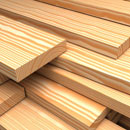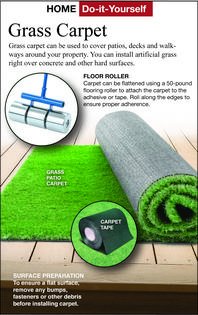Here's How: Improve Patio With Outdoor Carpeting
Dear James: My kids complain that playing on the concrete patio and wood deck is uncomfortable on their feet. Is there a softer, yet durable, covering I can put down? -- Vijay F.
Dear Vijay: Yes, it is available and works great for both patios and decks. It is similar to the simulated grass covering at miniature golf courses. It definitely feels better on feet than concrete does.
An additional advantage that comes along with grass carpeting is that, unlike wood, it is resistant to sunlight and bacteria, as well as mildew. To match your house, the carpeting comes in a variety of colors including reds, browns and greens.
Grass carpet is made of polypropylene plastic. Polypropylene is a fiber that works well for outdoor carpeting because it accepts brilliant pigments well but doesn't absorb water, like nylon does. Nylon, on the other hand, is more crush-resistant and has a better memory than polypropylene.
When choosing the color of the carpeting, consider that pale colors reflect light and make your area seem airier. Neutral and cool colors recede and seem farther away than they actually are. Make sure that the carpeting material that you select includes a blend of ultraviolet and color pigment stabilizers.
Indoor/outdoor carpeting comes in a variety of grades. You can tell the higher grades by the greater thickness of the carpet. For your specific area, which will be fully exposed to the weather, make sure you get an all-weather marine backing for water resistance. The lowest grade is the economy grass carpet. This is best for indoor areas or covered outdoor areas with little traffic. If you were to use grass carpeting in a basement area, the best type would be a berber loop with marine backing.
You might want to install the carpeting continuously from the outside deck to inside your house. This links the two together so they seem connected, instead of creating an abrupt break between outside and inside.
Before you do any purchasing, determine how much carpet you will need. It comes in 6-foot or 12-foot rolls. If you can't cover your entire surface with one roll, add extra in for seams. Be sure to put the seams in a low-traffic area, avoiding any focal points. To make them less noticeable, run the seams parallel with the strongest light source.
Indoor/outdoor carpeting can be laid loose or attached to the surface with double-sided tape or adhesive, but for general outdoor use, adhesive is best. The best type of adhesive to use depends on the backing and grade of the carpet and the surface material it will be installed on. Thoroughly clean and dry the surfaces before you begin installation. Plan the installation for a dry, sunny day.
Installation is fairly simple. You can usually find detailed instructions where you purchase your carpet. Once the carpet is laid down, let it dry completely for 72 hours. To connect one room to another, use a metal binder strip or aluminum saddle. Now your backyard is ready for your kids and you to relax without complaints of wounded feet.
========
Send your questions to Here's How, 6906 Royalgreen Dr., Cincinnati, Ohio, 45244 or visit www.dulley.com. To find out more about James Dulley and read features by other Creators Syndicate writers and cartoonists, visit the Creators Syndicate website at www.creators.com.
Copyright 2025 Creators Syndicate Inc.






























Comments